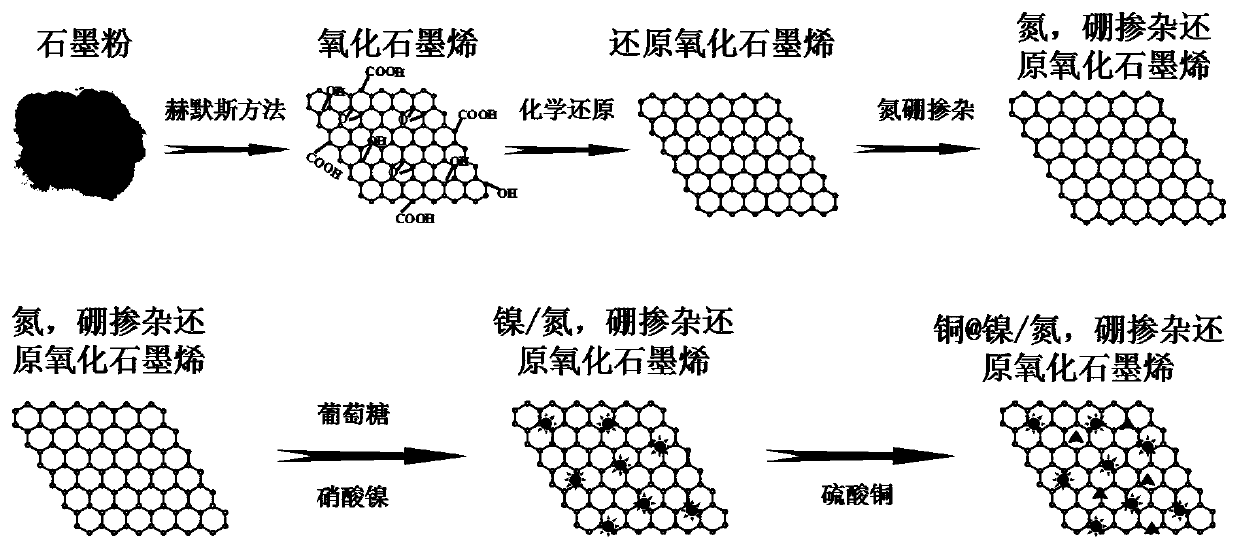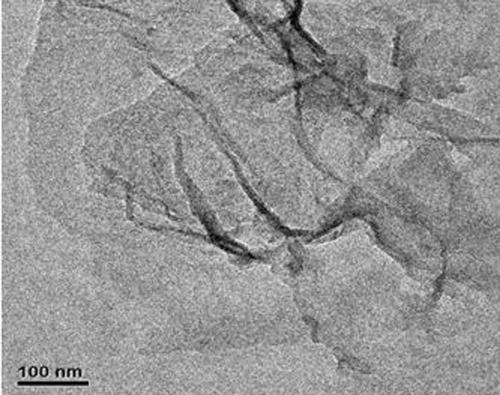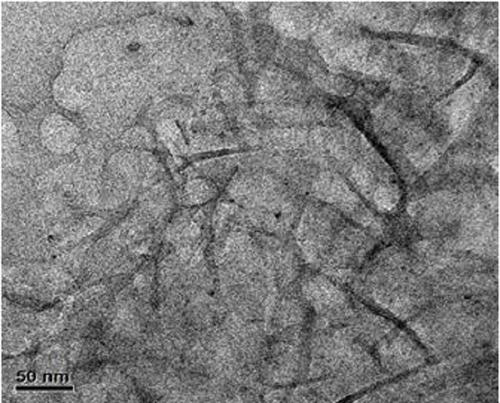Electrochemical sensor for simultaneously detecting guanine and adenine and preparation method thereof
A technology of adenine and guanine, which is applied in the field of electrochemical electrode material preparation, can solve the problems of weak electrochemical response, difficult simultaneous sensitive analysis and stable detection, etc., and achieves good stability and reproducibility, and improves the effect of selectivity.
- Summary
- Abstract
- Description
- Claims
- Application Information
AI Technical Summary
Problems solved by technology
Method used
Image
Examples
Embodiment 1
[0017] Embodiment 1: An electrochemical sensor for simultaneous detection of guanine and adenine, based on the composite material of copper@nickel / nitrogen, boron-doped reduced graphene oxide, the preparation method of the electrochemical sensor is:
[0018] (1) Preparation of nitrogen and boron doped reduced graphene oxide N,B-rGO by hydrothermal method: 10 mg of graphene GO was mixed with 20 ml of water, 40KHz ultrasonic treatment was performed for 10 min to 30 min, and GO was dispersed in water to form a concentration To a uniform GO suspension of 0.5 mg / mL, add dilute ammonia water with a mole fraction of 5%, adjust the pH of the suspension to 8.0, add 1.0 g of urea and 50.0 mg of boric acid to the suspension under vigorous stirring; put the mixture at room temperature Stirred at 120°C for 30 minutes, transferred to a Teflon-lined reactor at 120°C for 12 hours, then cooled in air, centrifuged at 12,000 rpm to collect N,B-rGO complexes and washed repeatedly with water and et...
Embodiment 2
[0023] Example 2: Characterization of the prepared electrochemical sensor modification process
[0024] Take the modified electrode prepared in Example 1, add 5.0 mM [Fe(CN) 6 ] 3- / 4- As a probe, the modification process of the electrode was characterized by cyclic voltammetry. Such as Figure 4 Shown: The peak current generated by the electrode after modification of nitrogen and boron doped reduced graphene oxide (N,B-rGO) increases slightly, which is due to its good conductivity. After modifying nickel / nitrogen and boron-doped reduced graphene oxide (Ni / N,B-rGO), the peak current is significantly improved due to the accelerated electron transfer efficiency on the electrode surface. After modifying copper@nickel / nitrogen and boron-doped reduced graphene oxide (Cu@Ni / N, B-rGO), the peak current is further significantly improved. Figure 4 It shows that the electrode modification process prepared in Example 1 is all successful.
Embodiment 3
[0025] Example 3: The electrochemical sensor prepared in Example 1 simultaneously detects guanine and adenine
[0026] Take the different modified electrodes prepared in Example 1 (bare electrode, nitrogen, boron doped reduced graphene oxide, nickel / nitrogen, boron doped reduced graphene oxide and copper@nickel / nitrogen, boron doped reduced graphene oxide), Electrochemical detection is carried out on the two base mixtures to be determined, and the cyclic voltammograms of guanine and adenine are obtained. After copper@nickel / nitrogen and boron doped reduced graphene oxide modified electrodes, the current signal was significantly enhanced, and the sensitivity of the sensor was greatly improved. Figure 5 It shows that the electrode modification process prepared in Example 1 is all successful, and guanine and adenine can be detected simultaneously.
PUM
 Login to View More
Login to View More Abstract
Description
Claims
Application Information
 Login to View More
Login to View More - R&D
- Intellectual Property
- Life Sciences
- Materials
- Tech Scout
- Unparalleled Data Quality
- Higher Quality Content
- 60% Fewer Hallucinations
Browse by: Latest US Patents, China's latest patents, Technical Efficacy Thesaurus, Application Domain, Technology Topic, Popular Technical Reports.
© 2025 PatSnap. All rights reserved.Legal|Privacy policy|Modern Slavery Act Transparency Statement|Sitemap|About US| Contact US: help@patsnap.com



